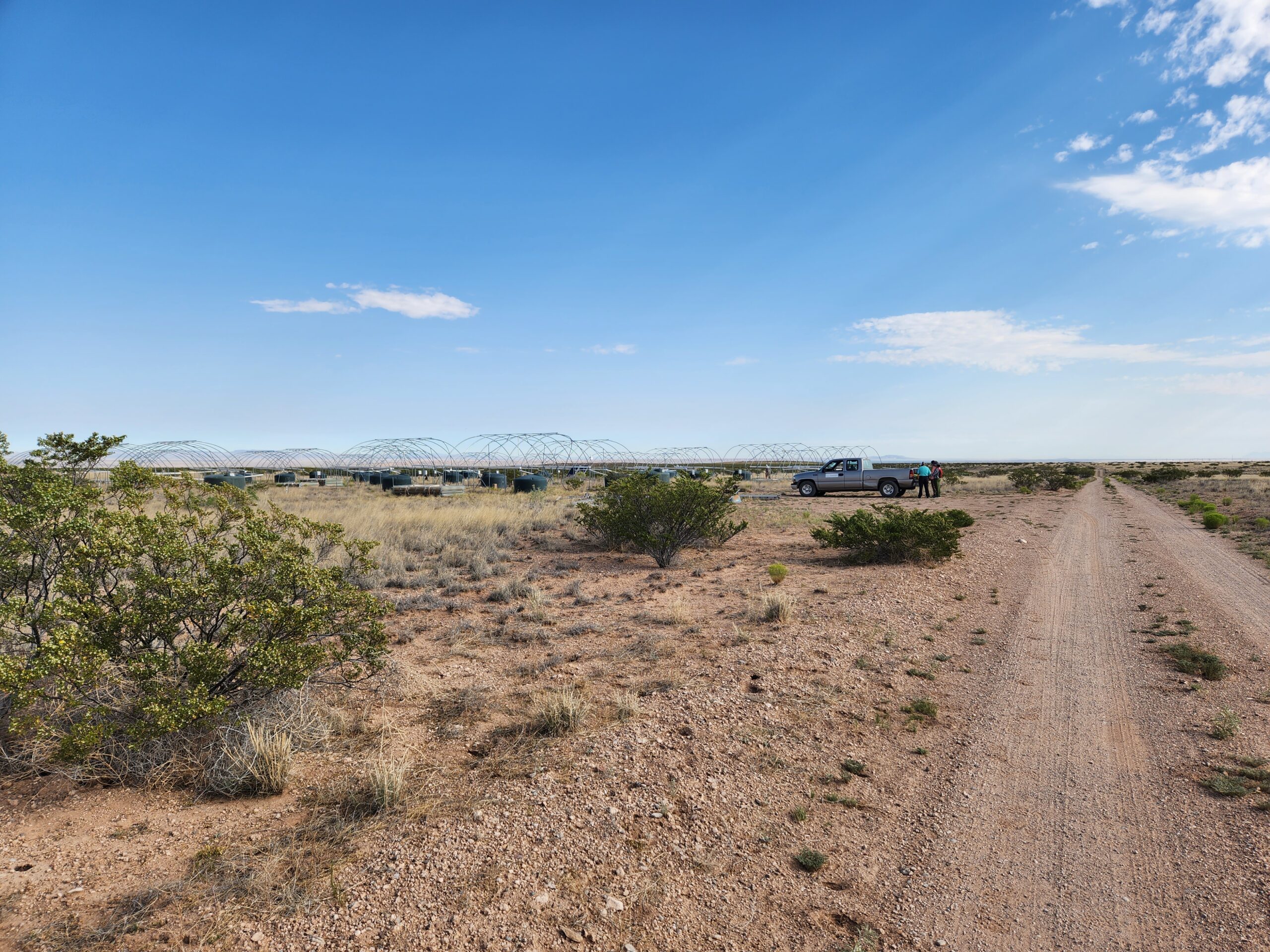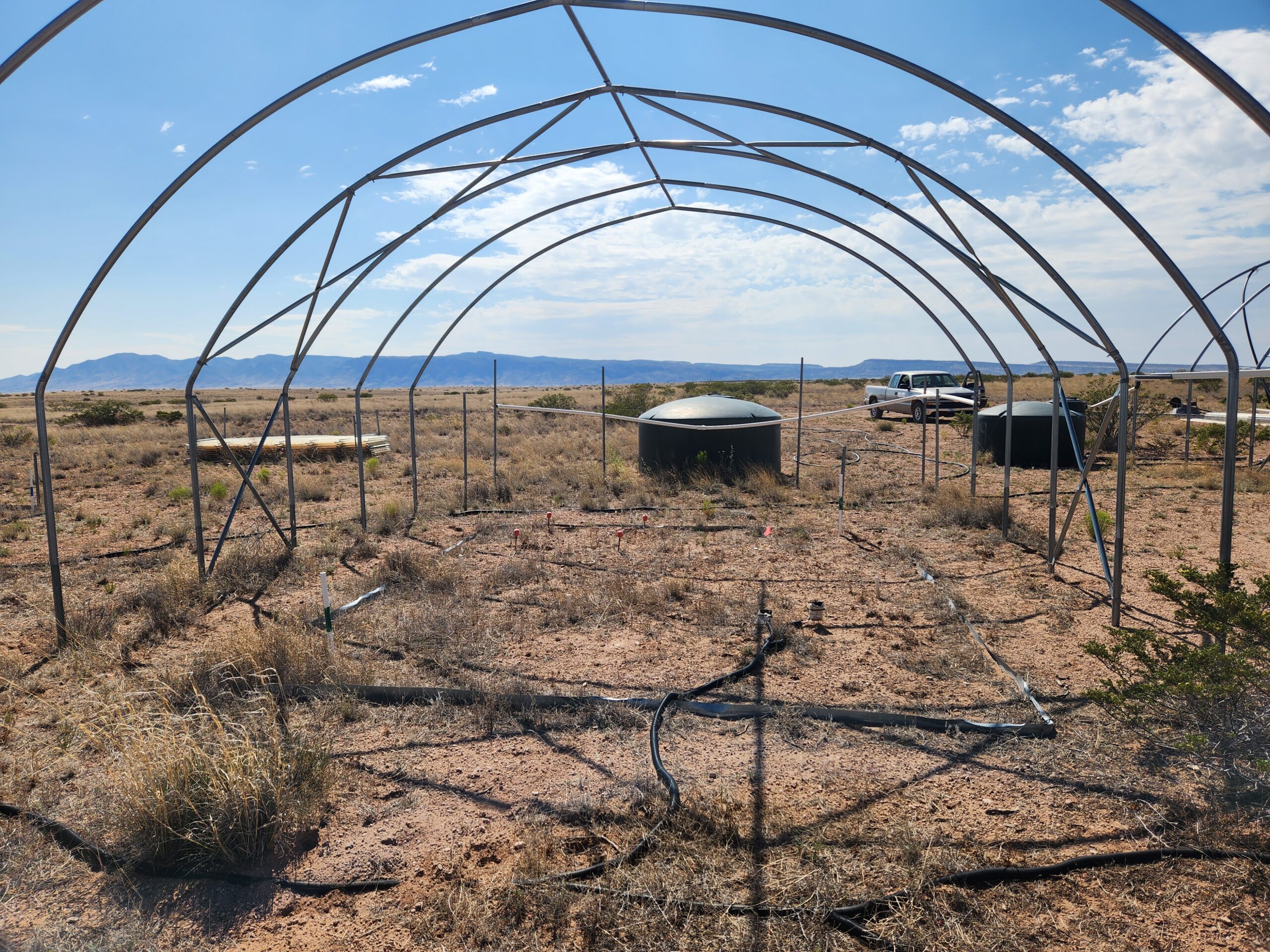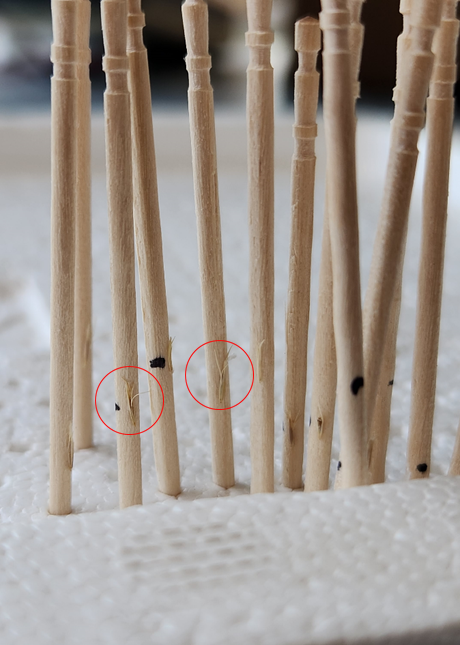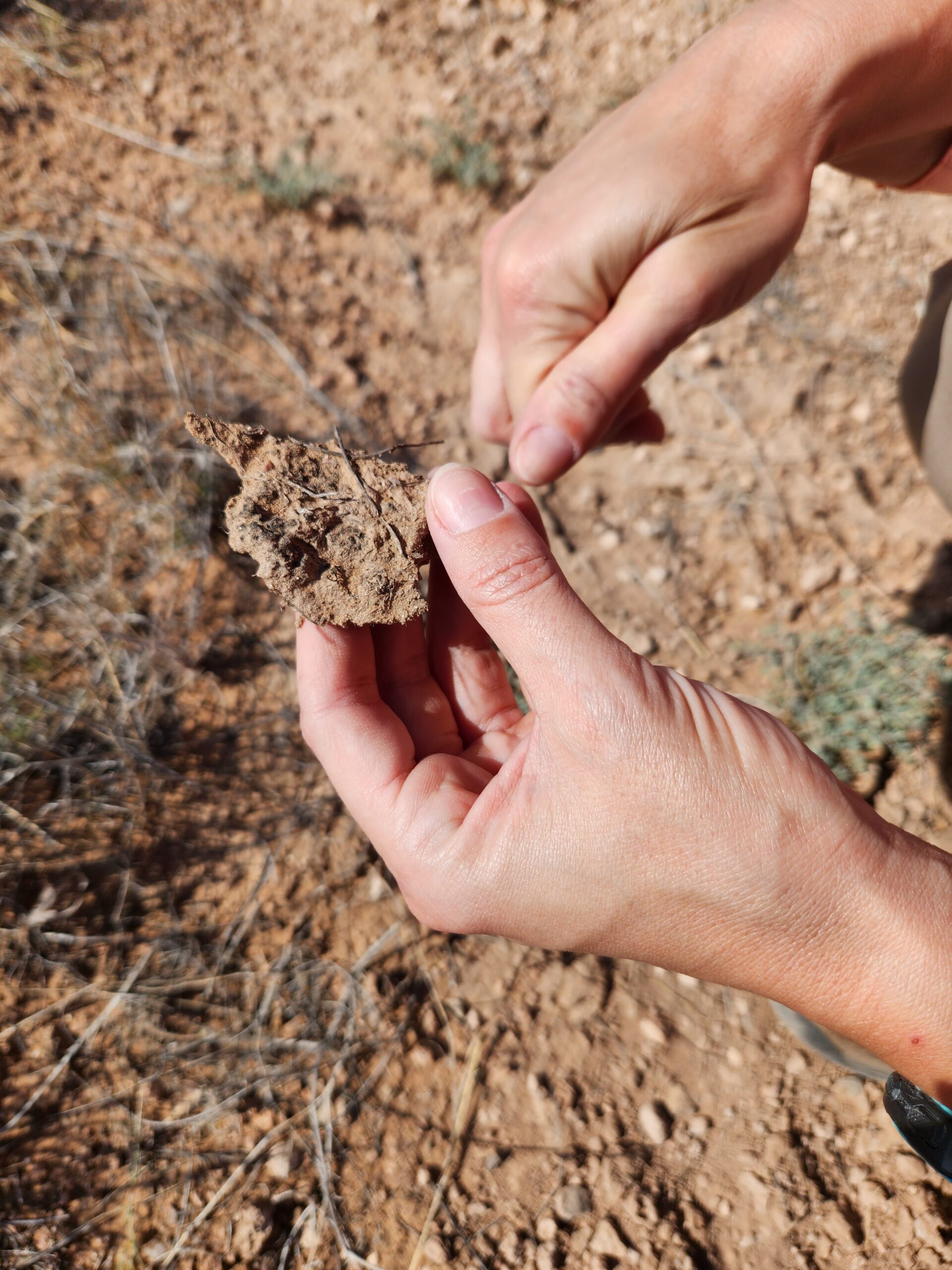A team of Sevilleta LTER researchers are leveraging an existing long-term drought experiment to build critical understanding of dryland ecosystem responses in the aftermath of extreme drought.
by Molly Reichenborn, PhD Candidate at New Mexico State University and the Jornada Basin LTER

Credit: Molly Reichenborn, CC BY-SA 4.0.
Change on the horizon
I met four researchers early in the morning to drive out to a field site at the Sevilleta National Wildlife Refuge hoping to beat the afternoon’s 95° F heat. The Sevilleta encompasses nearly 230,000 acres and multiple unique biomes in central New Mexico, including the Chihuahuan Desert, the short-grass prairie of the Great Plains, and the transition area or ecotone between these biomes. We piled into a truck and REU student Taeya Boi-Doku drove our group northeast towards a long-term manipulation experiment that would serve as our field site for the day. As we exchanged stories of working in the desert heat, we passed through the ecotone of these two iconic biomes, with the characteristic Chihuahuan Desert Black grama grass (Bouteloua eriopoda) dominating to the southwest, and abundant Blue grama (Bouteloua gracilis) to the northeast with the Great Plains biome just on the horizon.
We stopped at an experiment site situated within the Black grama grassland, already feeling the temperature steadily rise as we prepped sampling materials for the day. Current climate models consistently predict an increase in temperature and protracted, severe droughts in the southwestern United States by the end of the century. Future changes in the precipitation regime are less clear but may include delayed onset of the North American Monsoon, which delivers approximately 60% of the annual rainfall between July and September throughout the region.
The Extreme Drought in Grasslands Experiment (EDGE) at the Sevilleta LTER, as part of a multi-site effort within the LTER network, is designed to simulate long-term severe drought and delayed monsoon rainfall by capturing and rerouting natural rainfall, mimicking conditions expected under climate change. A second EDGE experimental site situated within the Blue grama grassland sits below the nearby Los Pinos Mountains to capture ecosystem responses across these two different biomes.

Credit: Molly Reichenborn, CC BY-SA 4.0.
Changing the present to understand the future
I followed behind Mariah Patton and Cassandra Maria Luz Miller, both doctoral students at the University of New Mexico (UNM), and UNM postdoctoral researcher Dr. Vanessa Fernandes (now an assistant professor at Florida Atlantic University) as they walked in between the study plots and oriented me to the infrastructure responsible for the EDGE treatments. Right before the monsoon season starts each year (typically in July), plastic panels are installed over some plots to intercept all rainfall during July and August. That water is redirected to large water storage tanks, where it is redistributed onto the plots as delayed rainfall in September and October.
Smaller panels are intermittently spaced over other plots to simulate severe drought. In these plots, 66% of ambient precipitation is intercepted during the growing season from April through mid-September. The response to this simulated drought was so severe that the treatment was discontinued after 7 years, though a decadal treatment was originally planned for the Sevilleta EDGE sites. “It’s been three years since the drought treatment was stopped,” Dr. Fernandes noted, “but if you go up to a droughted plot you’ll still see the effects of it.” As I walked past such a plot with little remaining vegetation, I could see exactly what she meant. This post-drought recovery period presented a rare opportunity to understand how ecosystems impacted by the prolonged, severe drought events expected with climate change will recover.
Stepping stones and seedlings

Credit: Molly Reichenborn, CC BY-SA 4.0.
After setting up, the group set to work on the primary focus for the day: Taeya’s summer REU project. Taeya joined the Sevilleta REU program for a variety of reasons, including the program’s opportunities for students to combine art and ecology, its focus on arid ecosystems, and a pathway for her to gain field research experience. “I focused a lot on environmental policy work previously; natural disaster management was really interesting to me,” Taeya explained as she prepared to apply a watering treatment related to her REU work. She had recently taken an environmental science class that included collecting water quality samples at an experimental lake and found she enjoyed the experience. “The REU program seemed like a good opportunity to see if field research and graduate school would be a good fit for me in the last year of my undergraduate program.”
For her REU project, Taeya investigated the effect of monsoonal precipitation on Black grama, a cornerstone grass species of the Chihuahuan Desert. Taeya established four subplots within the previously drought-treated plots and seeded them with 12 Black grama seeds each. Using a combination of a backpack sprayer, timer, and plastic cover to isolate the treatment, Taeya applied 200 milliliters of water to simulate a monsoonal rain event to subplots. Taeya then monitored the emergence of Black grama seedlings under high and low-watering schedules to understand how the frequency of rainfall events following drought could impact the success of this key species.
The tiny heroes of drylands

Credit: Molly Reichenborn, CC BY-SA 4.0.
As we walked among pockets of Black grama grass near the EDGE plots, Dr. Fernandes picked up a small sample of sandy soil with a blackened crust. The microbes on the soil surface responsible for the black color held together this otherwise loose soil into a cohesive “cookie,” a clear demonstration of their role in soil structure. Soil microbes are often underappreciated for their role in structuring ecosystems and how they respond to disturbances such as drought, but they have a critical role to play in drylands, including soil stabilization, nitrogen fixation, and carbon sequestration.
Dr. Fernandes and her collaborators want to understand how microbial communities affect an ecosystem’s response to drought. Cylinders containing samples of the rhizosphere, or the soil zone influenced by plant roots and associated microbiota, and biocrust, or communities of cyanobacteria, algae, lichens, and mosses on the soil surface, were extracted from control (“rainfall as usual”) and severely droughted plots after the drought treatment was discontinued in 2020. These 400 cylinders were then transplanted between different experimental plots, which should reveal how microbial communities impact plant recruitment and growth in plots with different precipitation histories.
Seeds of Black and Blue grama, the key grass species from the Chihuahuan Desert and Great Plains biomes respectively, were also added to these cylinders to track their germination as a measure of plant recovery, in addition to plant biomass and root size. Altogether, these measures will provide greater insight into how these small but critical communities respond to severe drought, how they recover, and how they influence the recovery of plant species.
Understanding the impact of drought on multiple fronts
As Taeya applied watering treatments, Dr. Fernandes, Mariah, and Cassandra collected soil samples to test soil aggregate stability on the experimental plots. Soil aggregates are an important indicator of the soil’s structure and function, which impacts how well plants can establish and survive, including Taeya’s Black grama seedlings. As the group worked together to characterize soil aggregate stability for Taeya’s project, Mariah, Cassandra and I talked about their graduate research on post-drought recovery.
Mariah has been tracking soil nutrient dynamics, especially plant available nitrogen, before the drought treatment was discontinued on the EDGE plots (2019) and in the initial years of drought recovery. She is currently analyzing soil samples collected from the transplanted cylinders to understand how phosphorus, nitrogen, and carbon cycling have been impacted in the years following drought.

Credit: Molly Reichenborn, CC BY-SA 4.0.
Cassandra grew Black and Blue grama individuals collected from drought-treated and control plots in soil extracted from the rhizosphere of each species, the control and drought-treated plots, and in sterilized soil (i.e., without soil microbia) to understand the relationship between the microbial communities and these key plant species across different drought legacies. This work was coupled with DNA sequencing on Blue grama individuals to determine if individuals from drought-treated plots display a unique drought-adapted genotype compared to those from control plots. While extreme events can lead to a significant loss in genetic diversity within a population, this can also spur adaptation to environmental conditions like prolonged drought as surviving individuals persist and reproduce.
After the soil stability data were collected and the water treatments were applied, the group packed up and headed back to the Sevilleta LTER headquarters for lab work. During a previous field trip, the group had collected several “cookies”, or small samples of the upper soil surface, as a pre-treatment snapshot of soil biocrusts within Taeya’s subplots before watering treatments began for the season. Taeya prepared the samples for analysis to detect two pigments, chlorophyll and scytonemin, to characterize the microbial community on the soil surface. “Chlorophyll serves as a proxy for cyanobacterial biomass; all cyanobacteria produce chlorophyll and it’s an easy proxy to extract.” Dr. Fernandes explained. “Scytonemin is the dark pigment excreted by nitrogen-fixing cyanobacteria for protection against the sun.” Though the presence of scytonemin can’t be used as a proxy for the biomass of these nitrogen-fixing species because it can be diluted by rain or wind, it can be used as an indicator of their presence and help researchers piece together a rough picture of the soil biocrust community.
Optimism in the face of a changing climate
After passing stories over a late lunch, promising to see each other at an upcoming conference, and waving good-bye, I loaded up my car and started the journey south to my home LTER site in the Jornada Basin. On my way home, I considered the central theme of the EDGE project and how omnipresent climate change has become in our lives: in the news, in the weather forecast, in our landscapes, and for many scientific disciplines, in our research. For better or worse, it’s hard to escape the reality of climate change, and even harder at times to remain optimistic in the face of that reality.
Despite all of that, I felt lighter on the way home. The researchers at the Sevilleta LTER and many other LTER sites across the network are contributing to our collective understanding of climate change and how our ecosystems will respond. While it may be one piece in the much larger climate adaptation puzzle, witnessing some of the research already in motion makes the future appear a bit brighter.










